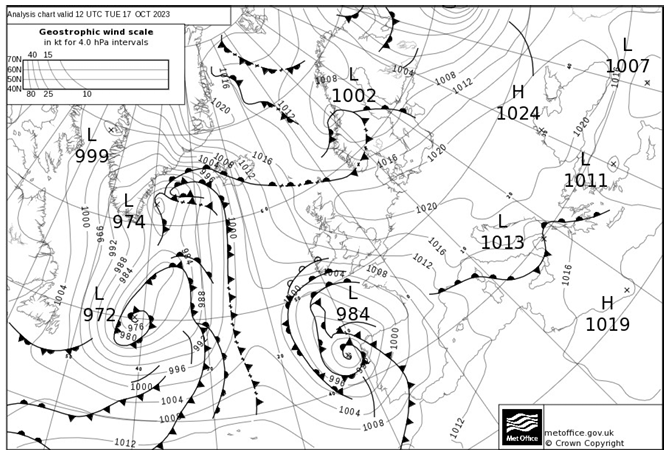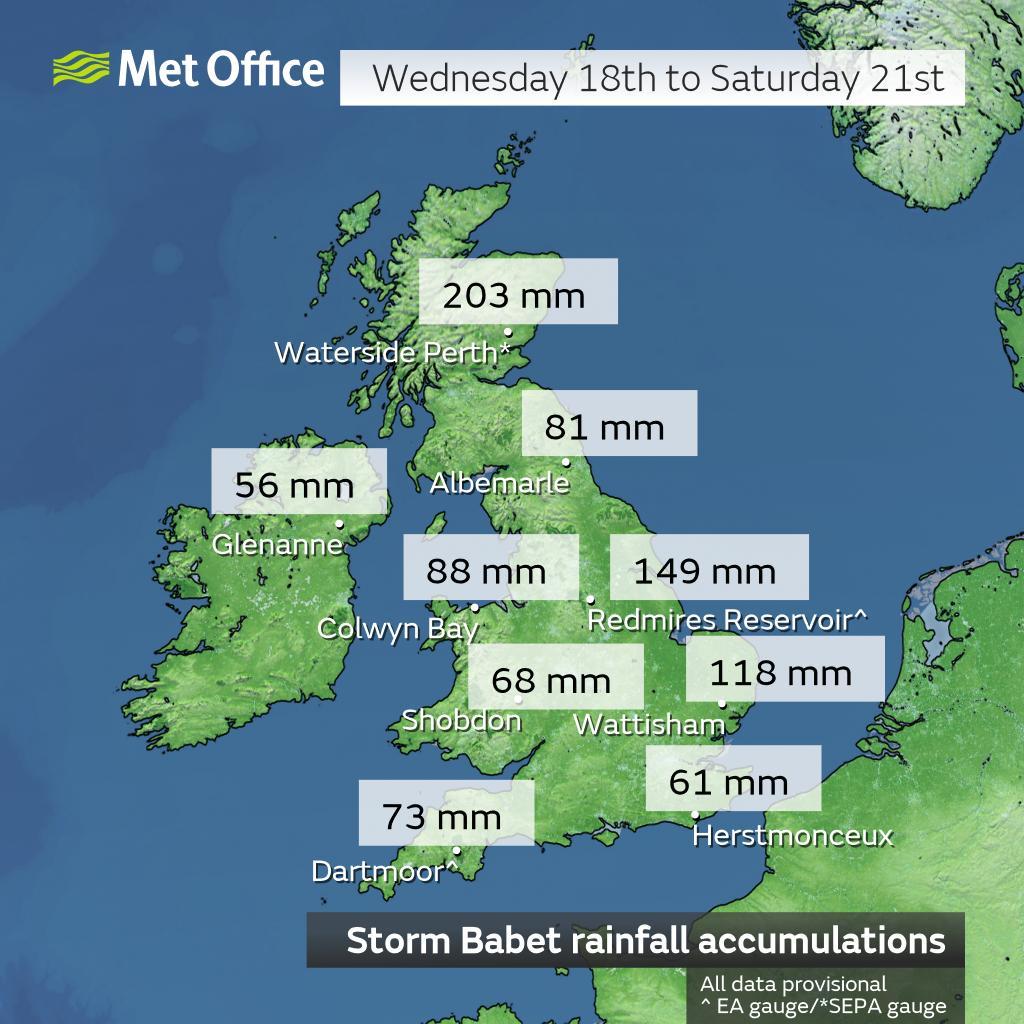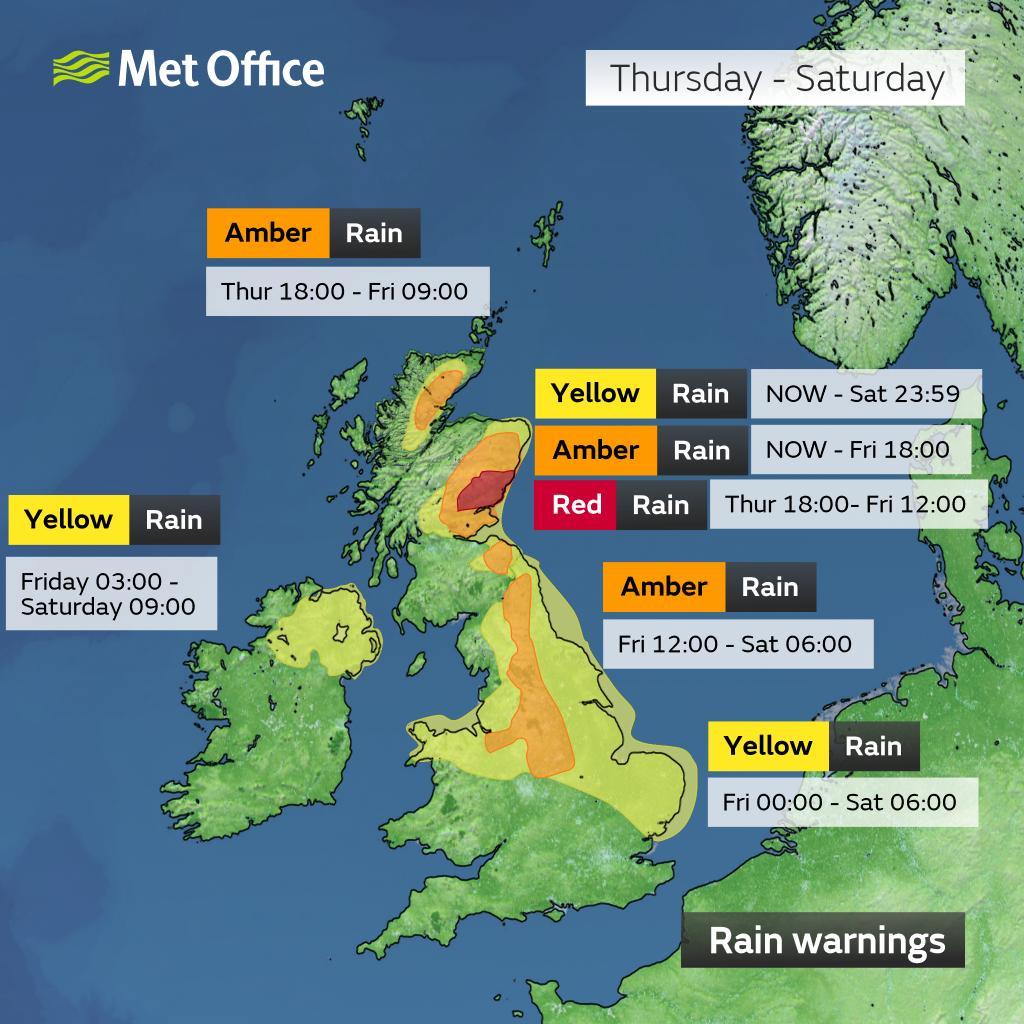Storm Babet was an extratropical cyclone that hit the United Kingdom on 21st October 2023. It was one of the most severe storms to hit the UK in recent years, causing widespread flooding and damage and claiming the lives of seven people. It was the second named storm to affect the UK during the 2023-24 season.
What caused Storm Babet?
Storm Babet was caused by a combination of factors, including:
- A strong jet stream, which helped to steer the storm towards the UK
- Warm sea surface temperatures in the North Atlantic Ocean, which provided the storm with energy
- A large area of low pressure over the UK, which helped to draw the storm in
- A blocking area of high pressure over Scandinavia prevented Babet from clearing eastwards.
The storm brought heavy rainfall and strong winds. Some locations experienced two months’ worth of rain in two days. Exceptional levels of rain fell in eastern parts of Scotland, with 150 to 200mm falling in the wettest areas.
According to the Met Office, this was the third-wettest independent 3-day period for England and Wales in a series from 1891, while the Midlands provisionally recorded its wettest 3-day period on record. This rain came on top of very wet weather earlier in October, with some central and eastern parts of England and Scotland recording more than twice the October whole-month average rainfall in the first three weeks of the month.
Babet also brought some powerful winds, gusting at over 50Kt (58mph) across northeast England and much of Scotland. A blocking area of high pressure over Scandinavia prevented Babet from clearing the UK eastwards into the North Sea. As a result, these wind speeds were sustained for a prolonged period. The persistent heavy rain and strong wind resulted in atrocious weather conditions for a sustained period, with a gust of 67Kt (77mph) at Inverbervie (Kincardineshire) and winds gusting at over 100Kt (115mph) across Scotland’s mountain summits.
Which areas were affected by Storm Babet?
Storm Babet affected large areas of the UK from 18 to 21 October 2023, with particularly severe impacts in eastern Scotland, Northern Ireland and northern England. Heavy rainfall and strong winds caused widespread flooding, power cuts and travel disruption.
Some of the worst affected areas included:
- Scotland: Brechin, Angus, which was only accessible by boat at one point, and Aberdeen, where several major roads were closed due to flooding. Flooding occurred after defences were overtopped by the river South Esk.
- Northern Ireland: Retford, Nottinghamshire, where an evacuation order was issued for parts of the town, and Derry, where flooding caused widespread damage.
- Northern England: Leeds, Sheffield and York, where roads and railways were closed due to flooding, and Derbyshire and Nottinghamshire, where rivers exceeded record levels.
A dog walker captured this incredible footage of trees moving in the wind in Mugdock, Stirlingshire.
What were the impacts of Storm Babet?
Storm Babet had a significant social impact on the UK. The storm caused widespread flooding, which forced thousands of people to evacuate their homes. It also caused damage to infrastructure and businesses and led to power outages for hundreds of thousands of people.
The storm also had a significant impact on the environment. The heavy rains caused rivers to overflow and landslides to occur. This caused damage to wildlife habitats and polluted water supplies.
What were the social impacts of Storm Babet?
Storm Babet had a significant impact on the social fabric of the UK. Thousands of people were forced to evacuate their homes, and many lost their belongings and livelihoods. The storm also disrupted transport, education, and other essential services.
Examples of social impacts:
- Deaths: Seven people died due to the effects of the storm, which included heavy rainfall, leading to flooding, and high winds causing trees to topple.
- Evacuations: Over 10,000 people were evacuated from their homes due to flooding. Many people were forced to stay in temporary accommodation, such as shelters and hotels.
- Homelessness: Hundreds of people are homeless after flash floods followed heavy rain. An estimated 1,250 properties in England were flooded, while about 30,000 properties needed flood protection, according to the Environment Agency. The storm also caused damage to rental properties, making it difficult for people to find affordable housing.
- Schools: Schools across Angus, Scotland, were closed.
What were the economic impacts of Storm Babet?
Storm Babet caused billions of pounds worth of damage to infrastructure and businesses. The storm also disrupted economic activity, such as tourism and agriculture.
Examples of economic impacts:
- Damage to infrastructure: The storm caused damage to roads, bridges, railways, and other infrastructure. This led to disruption to transport and other essential services.
- Impact on transport: Leeds Bradford Airport was closed on 20th October after a large plane skidded off the runway whilst landing. Kings Cross railway station was closed due to overcrowding caused by disruption to rail services. Rail passengers were told to avoid travel after lines were flooded and LNER services north of Edinburgh were cancelled. Many other services were cancelled due to damage to overhead electricity lines, such as services between Cheadle Hulme and Wilmslow. Trains were also not able to travel between Leeds and Bradford and Doncaster and Harrogate. The main A90 trunk road was closed between Forfar and Brechin after storm Babet damaged a bridge.
- Loss of power: Storm Babet disrupted power supplies, with around 100,000 customers initially losing power.
- Damage to businesses: Many businesses were damaged by flooding and power outages. This led to job losses and disruption to economic activity. Forty-five workers were airlifted off a North Sea drilling platform after it lost anchors during the storm.
- Lost revenue: The storm caused billions of pounds in lost revenue for businesses. This was due to damage to property, disruption to supply chains, and reduced demand for goods and services.
- Impact on agriculture: Storm Babet had a significant impact on UK agriculture, causing widespread damage to crops, livestock and farmland. Existing crops have been damaged, and flooded fields mean farmers cannot carry out work from harvesting the current crops to planting the next. This will lead to lower yields, financial losses for farmers and disruptions to food supplies.
What were the environmental impacts of Storm Babet?
Storm Babet had a significant impact on the environment. The heavy rains caused flooding, landslides, and pollution. The storm also damaged wildlife habitats and ecosystems.
Examples of environmental impacts:
- Flooding: The storm caused widespread flooding, which damaged rivers, lakes, and wetlands. The flooding also displaced wildlife and polluted water supplies.
- Landslides: The heavy rains caused landslides in some areas. This damaged forests and other natural habitats.
- Pollution: The storm caused pollution to water supplies and wildlife habitats. This was due to factors such as sewage overflows and agricultural runoff.
- Soil erosion: Top soil was eroded from exposed fields, increasing river nitrate levels as the eroded material reached watercourses.
How did management strategies reduce the risk of Storm Babet?
A number of management strategies were in place to reduce the risk posed by Storm Babet. These included:
- The Met Office issued early warnings about the storm, giving people time to prepare. The Met Office issued two red warnings for persistent heavy rain across eastern Scotland from 19th to 20th and 21st October, with several other amber warnings for rain and wind covering Scotland, Northern Ireland, Wales and parts of northern England, as well as more widespread yellow warnings. The last time the Met Office issued a red warning for rain was from Storm Dennis in mid-February 2020, covering parts of South Wales.
- The Environment Agency (EA) issued flood warnings and alerts and deployed sandbags and other measures to protect communities from flooding. More than 150 flood warnings remained in place on 22 October. Scotland and Wales also had several flood warnings in place.
- The EA’s flood warning service sent out over 300,000 messages by email, telephone and text during Storm Babet.
- An estimated 96,000 properties were protected as part of the Environmental Agency’s response to flooding. Twenty high-volume pumps and five small pumps were deployed across several sites.
- Local authorities and emergency services put in place plans to respond to the storm and its aftermath.
- The government announced support for those affected by Storm Babet, including flooded households being able to apply for up to £500 to help with immediate costs, and small to medium-sized businesses are eligible to apply for up to £2500 from the business recovery grant to return to business. Flood-hit property owners can apply for up to £5,000 to help make their homes and businesses more resilient to future flooding.
These management strategies helped to reduce the risk posed by Storm Babet and to mitigate its impacts. However, the storm was still very severe and caused significant damage.
Interested in finding out more about Storm Babat? Watch the Met Office Deep Dive below.




